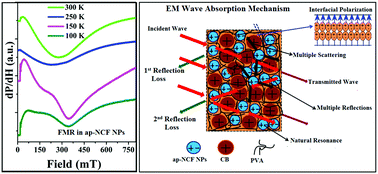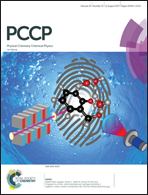Ferromagnetic resonance of NiCoFe2O4 nanoparticles and microwave absorption properties of flexible NiCoFe2O4–carbon black/poly(vinyl alcohol) composites†
Abstract
The effect of cationic disorder and particle morphology on the ferromagnetic resonance (FMR) of NiCoFe2O4 nanoparticles (NPs) and the electromagnetic shielding effectiveness of flexible composites (wherein the nanoparticles are used as fillers) has been presented. Upon annealing at 1000 °C, spherical, ∼25 nm, single crystalline (as-prepared) NPs are transformed into octahedral, ∼200 nm, polycrystalline (annealed) NPs and change the cationic distribution significantly. The effect of shape, size and cationic distribution on the resonance properties has been discussed using the randomly-oriented anisotropic-axis model. The temperature dependent evolution of FMR spectra has been found to be consistent with a Bloch spin-relaxation model. Analysis of the FMR spectra reveals that NiCoFe2O4 nanoparticles have a large internal magnetic field along with broad FMR linewidths of ∼2–3 kOe, signifying high magnetic losses that are essential for the absorption of electromagnetic (EM) waves. Next, NiCoFe2O4–carbon black (NCF–CB) hybrids grafted in a PVA matrix, as flexible composite films with a thickness of ∼1.5 mm, are assessed for EM wave absorption properties in the range of 8–18 GHz. As compared to annealed-NCF–CB/PVA (21 dB, ∼99.5%), the as-prepared-NCF–CB/PVA composite film exhibits significantly large SE of 27 dB (∼99.9% attenuation of the EM wave), with a dominant contribution from absorption (SEA ∼ 21 dB). The electrical conductivity, the electric modulus, and Cole–Cole plots reveal that the dielectric losses in the as-prepared-NCF–CB/PVA have significant contributions from cationic disorder and particle size, as compared to the annealed-NCF–CB/PVA composites. Cationic disorder increases the d–d electron transition probability between adjacent ionic pairs such as Co2+/Fe3+ and a reduced particle size creates large interfacial polarization in the as-prepared NCF/CB hybrids. Considerably large values of the Landes g-factor, magnetic anisotropy and better impedance matching indicate a dominant magnetic loss contribution in ap-NCF (g = 4.5) as compared to an-NCF (g = 2.5) at 300 K.



 Please wait while we load your content...
Please wait while we load your content...